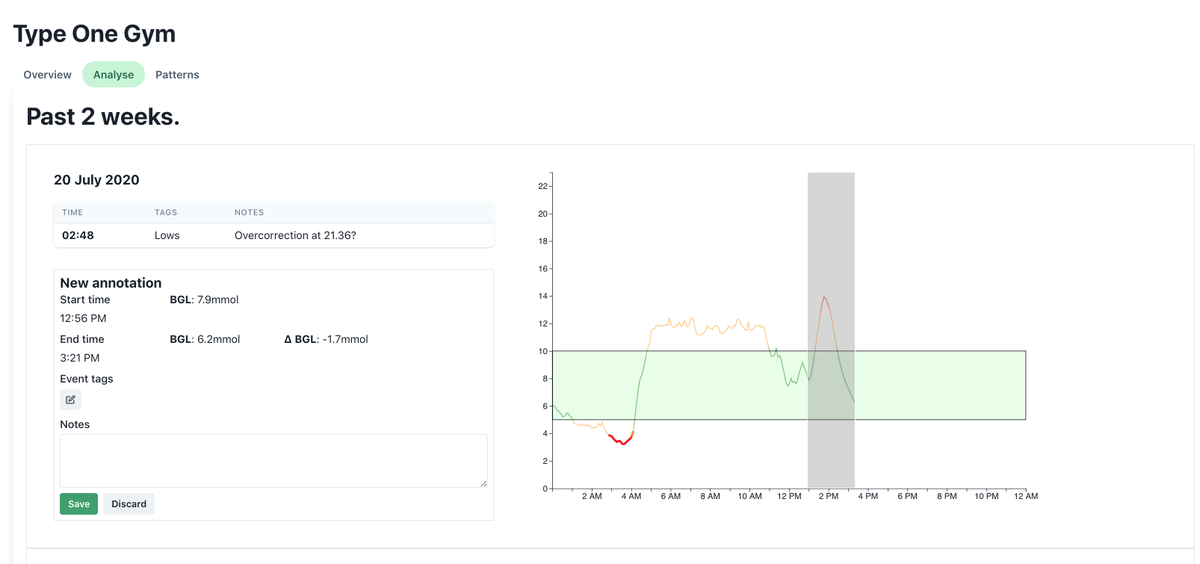#T1D #diabetes #wearenotwaiting
Annotations are highlighted in your graph too ;)
#t1diabetes #WeAreNotWaiting
#t1diabetes #WeAreNotWaiting #t1gym

You're running experiments to determine parameters of your body's metabolic model.
Sleep, exercise, the types of food (high GI, low GI)...these all are variable.
mendosa.com/The-Fat-of-the…
And it works for a bit. There are rough rules - insulin follows a nonlinear release curve, carbs follow a linear curve, weighted by GI, exercise is constant 🔥.
For example, I find that if I've got a high blood glucose level (BG), I'll be more resistant to insulin.
@bustavo has a great post on this bustavo.com/predicting-bg-…
Nowdays, we use a closed loop system. These involve a realtime glucose feed (CGM), an insulin pump, and a controller (an app or rig).
It's autopilot for insulin.
Now I'm experimenting with something more similar to training NN's. Plain iterative optimization.
This is starting to be useful!

We went on a 10km hike today. Thanks to the Loop app, I can enter carbs and get them into my Nightscout pretty easily.
Even though Loop is great, it can't yet inject glucose ;) So you still have to keep track of carbs as a diabetic, for exercise.
#WeAreNotWaiting
A) Overdose/underdose - problem with insulin ratios.
B) Missed bolus - my fault.
C) Exercise - separate area for improvement.
Goal: 0 of category A, minimise B/C.
👉 Given how mainstream looping will be with @Tidepool_org's Loop, I wonder why the #WeAreNotWaiting community hasn't come up with any standards? eg. RFC's
And no, Nightscout's swagger.yml does not count 😅
Related that I only just understood something as seemingly basic as alcohol. She told me she's had it for 30yrs & only got it at yr 15 😱
Thinking about what I've done in those 6-9mo, I can say that only in the past 3 have I really understood the patterns better.
👀 Patterns - exercise, drinking🍺 , low GI foods (pizza) and protein, hyperglycemic (high BG) insulin resistance
🔢 Settings - basal rates, morning sensitivity, correction ratios
You have roughly 3-4 good days each week to optimize + improve. This includes reserving some downtime (you don't want burnout) and room for error (eg. things out of your control).
(1) Basal testing, in three 8h blocks (ie. morning, daytime, nighttime). This involves fasting, so it's humane to only test one block each day.
There's room for error here, if you're not astutely aware of carb content. eg. I recently learned onions have just a little carbs in them
Both of these usually require some sort of dual wave bolus delivery on a pump. I set it at 2H, delivering 50% now and delivering the other 50% over 2h. Might be different for others.
❗️eating at intervals, rather than snacking. Cause-effect becomes so much clearer.
❗️reducing variance around start/end of day, eating the same breakfast/dinner
❗️eating low GI foods (lentils) which don't spike your levels
- adjusting behavioural patterns of bad mgmt (ie. bolusing less because you're scared of going low in a social setting)
- illness, stress, hormones, womens health (periods)
- quality of sleep
I shouldn't be receiving PDF's of scanned printouts over email as an appointment reminder. Or god forbid, the actual post.
Appointments every 3mo? How about improving every week
- you can actually label your sugar levels and quickly identify patterns
- ask questions to your endo **in context**, like it's a Google Doc.
- progress through a defined rubric, rather than having the same convo 20x over at the doc's
- how alcohol works
- how fat affects digestion speeds
- women's health
- apps you can use to count carbs
- community-recommended strategies (eg. when going out)
- loop
woke: using brainpower to analyse patterns, optimize health, collaborate seamlessly
* FreeStyle Libre for realtime CGM
* @Tidepool_org uploader to get pump/CGM data in normalised formats.
* T1 Gym to visualise/diagnose/progress the journey.
* Healthcare specialists (endos) to answer Q's and vet knowledge.
* Community knowledge base.






















